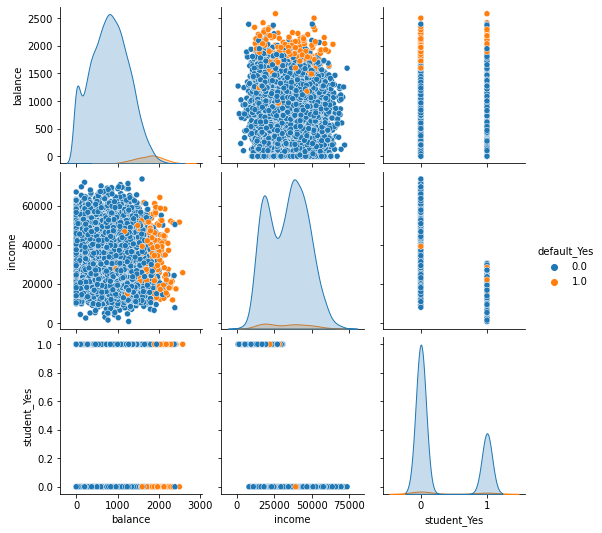Credit data
Contents
Credit data#
The credit data is a simulated data set containing information on ten thousand customers (taken from James et al. [2021]). The aim here is to use a classification model to predict which customers will default on their credit card debt (i.e., failure to repay a debt):
default: A categorical variable with levels No and Yes indicating whether the customer defaulted on their debt
student: A categorical variable with levels No and Yes indicating whether the customer is a student
balance: The average balance that the customer has remaining on their credit card after making their monthly payment
income: Income of customer
Import data#
import pandas as pd
df = pd.read_csv('https://raw.githubusercontent.com/kirenz/classification/main/_static/data/Default.csv')
Inspect data#
df
| default | student | balance | income | |
|---|---|---|---|---|
| 0 | No | No | 729.526495 | 44361.625074 |
| 1 | No | Yes | 817.180407 | 12106.134700 |
| 2 | No | No | 1073.549164 | 31767.138947 |
| 3 | No | No | 529.250605 | 35704.493935 |
| 4 | No | No | 785.655883 | 38463.495879 |
| ... | ... | ... | ... | ... |
| 9995 | No | No | 711.555020 | 52992.378914 |
| 9996 | No | No | 757.962918 | 19660.721768 |
| 9997 | No | No | 845.411989 | 58636.156984 |
| 9998 | No | No | 1569.009053 | 36669.112365 |
| 9999 | No | Yes | 200.922183 | 16862.952321 |
10000 rows × 4 columns
df.info()
<class 'pandas.core.frame.DataFrame'>
RangeIndex: 10000 entries, 0 to 9999
Data columns (total 4 columns):
# Column Non-Null Count Dtype
--- ------ -------------- -----
0 default 10000 non-null object
1 student 10000 non-null object
2 balance 10000 non-null float64
3 income 10000 non-null float64
dtypes: float64(2), object(2)
memory usage: 312.6+ KB
# check for missing values
print(df.isnull().sum())
default 0
student 0
balance 0
income 0
dtype: int64
Data preparation#
Categorical data#
First, we convert categorical data into indicator variables:
dummies = pd.get_dummies(df[['default', 'student']], drop_first=True, dtype=float)
dummies.head(3)
| default_Yes | student_Yes | |
|---|---|---|
| 0 | 0.0 | 0.0 |
| 1 | 0.0 | 1.0 |
| 2 | 0.0 | 0.0 |
# combine data and drop original categorical variables
df = pd.concat([df, dummies], axis=1).drop(columns = ['default', 'student'])
df.head(3)
| balance | income | default_Yes | student_Yes | |
|---|---|---|---|---|
| 0 | 729.526495 | 44361.625074 | 0.0 | 0.0 |
| 1 | 817.180407 | 12106.134700 | 0.0 | 1.0 |
| 2 | 1073.549164 | 31767.138947 | 0.0 | 0.0 |
Label and features#
Next, we create our y label and features:
y = df['default_Yes']
X = df.drop(columns = 'default_Yes')
Train test split#
from sklearn.model_selection import train_test_split
X_train, X_test, y_train, y_test = train_test_split(X, y, test_size=0.3, random_state = 1)
Data exploration#
Create data for exploratory data analysis.
train_dataset = pd.DataFrame(X_train.copy())
train_dataset['default_Yes'] = pd.DataFrame(y_train)
import seaborn as sns
sns.pairplot(train_dataset, hue='default_Yes');


